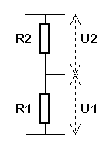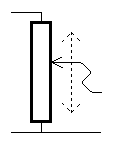3.
Wo immer Strom fließt,
haben Sie es mit
Spannungsteilern zu tun |
|
3.
Wherever current flows,
you have to deal with voltage dividers. |
| Hier ist eine Batterie gezeichnet. Sie hat, ob
Sie das wollen oder wahrhaben, einen Innenwiderstand. Er besteht aus dem
Widerstand der Zuleitung und aus chemisch-galvanischen Widerständen.
Das selbe gilt für einen Generator und für einen Transformator.
Da ist natürlich nicht wirklich ein Widerstand eingebaut, das ist
nur eine schematische Zeichnung, ein "Ersatzschaltbild".
Der Lastwiderstand RL "bekommt" nicht die ganze Batteriespannung
an den Klemmen geliefert, weil ein Teil im Innenwiderstand Ri
der Batterie verloren geht. |
 |
Here a battery is drawn. It has an inner resistance,
regardless if you want or consider that. It consists of the wire resistance
and of chemo-galvanic resistors. The same applies to a generator and a
transformer..
There is not really a resistor built in of course, the drawing is schematic
only.
The load resistor RL does not "get" the whole voltage of
the battery at the terminals, because a part is lost in the inner resistance
Ri of the battery. |
Annahme:
Batterie 12V, Ri = 0,5 Ohm |
Assumption:
Battery 12V, Ri=0.5 Ohm |
| RL Ohm |
I |
UL |
Pi |
PL |
| 100 |
0,12A |
11,94V |
7mW |
1,43W |
| 20 |
0,59A |
11,71V |
170mW |
6,85W |
| 10 |
1,14A |
11,43V |
0,65W |
13,1W |
| 5 |
2,18A |
10,91V |
2,38W |
23,8W |
| 2 |
4,8A |
9,6V |
11,5W |
46,1W |
| 1 |
8A |
8V |
32W |
64W |
| 0,5 |
12A |
6V |
72W |
72W |
| 0,2 |
17,14A |
3,43V |
147W |
58,8W |
| 0 |
24A |
0V |
288W |
0W |
|
| Diese Tabelle erklärt einem Anfänger viele Zusammenhänge
aus der Elektrotechnik ohne große "Wissenschaft". Es lohnt sich,
daß wir sie uns etwas genauer ansehen. |
. |
This table can explain a beginner a lot of matters in electrical engineering
without "big science". It is worth looking at it in more depth. |
| Zuerst einmal betrachten wir
nur die "normale " Belastung der Batterie, etwa bis herunter zum 5-Ohm
Lastwiderstand.
Bei kleiner Belastung mit 0,12A ist die Klemmenspannung der Spannungsquelle
praktisch gleich mit der Leerlaufspannung, aber bei 5 Ohm Last sinkt sie
bereits unter 11V. Die entnommene Leistung ist dabei 24W, aber auch die
Batterie wird sich schon etwas erwärmen, mit 2,4W Verlustleistung. |
|
First we consider the "nominal"
load conditions of the battery only, down to 5 ohms load resistance.
With very little load (0.12A) the voltage at the terminals of the voltage
source is almost equal to the no-load voltage, but with the 5 ohm load
the terminal voltage drops down to below 11V.
The power drawn from the source is 24W but the battery itself is heated
with 2.4W power loss. |
| Mit steigender Belastung steigt nicht nur die Stromstärke und
die Nutzleistung, sondern auch die Verlustleistung in der Batterie enorm
an.
Bei einem Lastwiderstand von 0,5 Ohm ist die Klemmenspannung auf die
Hälfte gesunken und die Verlustleistung ist gleich groß wie
die Nutzleistung.
Bei weiter sinkendem Lastwiderstand steigt die Verlustleistung extrem
hoch an, die Nutzleistung aber sinkt. Das ist natürlich alles kein
Normalbetrieb mehr, bis zum Kurzschluß.
Aber es gibt andere Typen von Stromquellen, die normalerweise mit einem
Widerstandswert belastet werden, der ihrem Innenwiderstand entspricht. |
. |
With increasing load not only the current and
the payload power increases, but also the power losses rise enormously.
With a 0.5 ohm load resistor the terminal voltage decreases to one half
and the power losses are equal to the payload power.
With even further decreased load resistance the power losses grow extremely
high, but the payload power decreases!
Of course this is not a nominal operation of the battery, down to the
short circuit.
But other types of voltage sources are typically loaded with a resistance
value that is equal to the source resistance. |
Diese Batterie hat 2 Kenngrößen:
Leerlaufspannung = 12V
Kurzschlußstrom = 24A |
|
This battery has 2 significant values:
No-load voltage = 12V
Short-circuit current = 24A |




